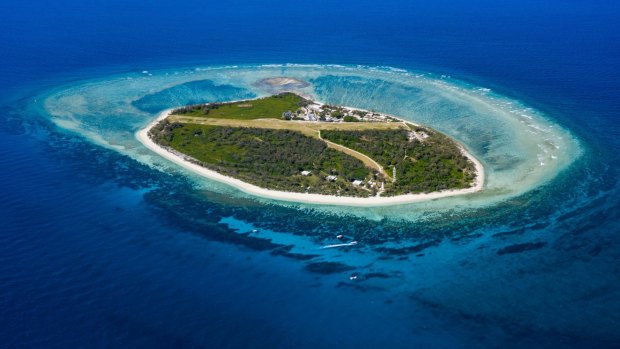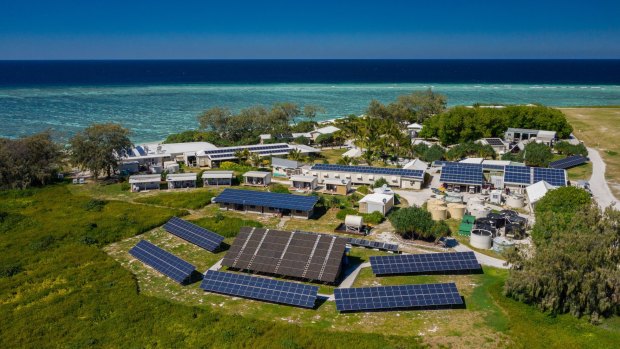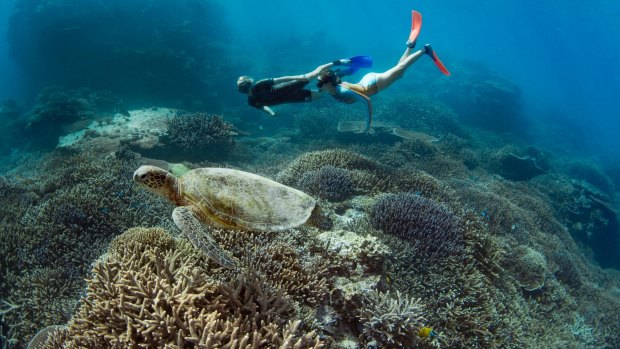This was published 3 years ago
Lady Elliot Island Eco Resort: How a former camp for collecting poo became an Aussie paradise
By David McGonigal

Lady Elliot Island's history is a tale of redemption as it has evolved from guano mining in the 1870s to a beacon of sustainable tourism today.
The large green turtle swims into sight 30 minutes before the plane is due to take us off the island. The three of us swim together through the tranquil tropical water of the lagoon past coral and schools of small fish. He continues while we swim to shore, to our towels, our clothes, our luggage and our flight. It's a serene ending to an idyllic island sojourn.
The flight to Hervey Bay is a short hop so the ocean is never far below on the flight from Lady Elliot Island. Taking off from the grass runway, we circle the island, an aquamarine jewel surrounded by coral reefs and "our" lagoon and minutes later see the mainland coast ahead. Our island escape has ended.
Lady Elliot Island is special. It's at the very southern end of the Great Barrier Reef, a true coral atoll when most resorts are on continental islands. It owns its very existence to growing coral and nesting birds. Down this end of the Reef, the coral is spectacular and the bird population (particularly noddies) well on the plus side of abundant.

Lady Elliot has turned green, from island restoration, solar power, sophisticated recycling and composting to sugar cane toilet paper.
The island's history is a tale of redemption as it has evolved from guano mining in the 1870s to a beacon of sustainable tourism today. For much of its history, it was merely the site of the now-historic lighthouse until the first basic resort was established in 1969.
I first visited in 1985, soon after the owner at the time bought the buildings of a disused Queensland mining camp and had them shipped to the island. While the accommodation and cuisine were rudimentary, the reef was magical. A trial dive where a squadron of manta rays used us as a slalom course led to me becoming a certified diver. After many dives worldwide, I now better appreciate the spectacle of hundreds of manta rays gathering here in the winter months.
There's some trepidation upon my return. The earlier resort had rustic charm in a natural wonderland. Would it have gentrified to a level where it was more about lists of cocktail than species of fish? It accommodates more people these days (150 overnight guests and 100 day visitors, though those numbers are reduced in the age of COVID-19) so would it seem unsustainably busy? Would it now be more about resort wear than wetsuits?

Snorkelling in the lagoon is best done around the top of the tide.
Fortunately, my fears are unfounded. While the accommodation is much improved, the décor isn't fussy and cocktail hour is the time when guests walk to the lighthouse beach on the far side of the island to sit and watch the sun set over the water while being served cheese and wine.
Since 2005, under the watchful eye of resort owner Peter Gash, Lady Elliot has turned green, from island restoration, solar power, sophisticated recycling and composting to sugar cane toilet paper. It has many awards and eco accolades to acknowledge its achievements.
Time and tide dictate the course of each day on the island that is, in effect, a mothership to the surrounding ocean. The sun rises over the lagoon and sets across the Coral Sea. Snorkelling in the lagoon is best done around the top of the tide, while more adventurous boat dives and snorkelling trips shift locations for the best visibility and wildlife.
At night, you can explore coral bio-luminescence on a walking tour or drop into bed after a very full day. There's no TV or radio but there's a constant background of bird squabble and perhaps the swoosh of a sea turtle digging her nest to lay her eggs. Home immediately seems much less exotic and a long way away.
THE DETAILS
STAY
There's a range of accommodation with prices per person per night from $199 in low season to $440 in high season. That includes breakfast and dinner, snorkelling equipment and some tours.
FLY
Flights to the island's airstrip are on a Seair Pacific Cessna Caravan from Hervey Bay, Bundaberg, Gold Coast and Brisbane (Redcliffe).
MORE
David McGonigal was a guest of Lady Elliot Island Eco Resort.
Sign up for the Traveller Deals newsletter
Get exclusive travel deals delivered straight to your inbox. Sign up now.